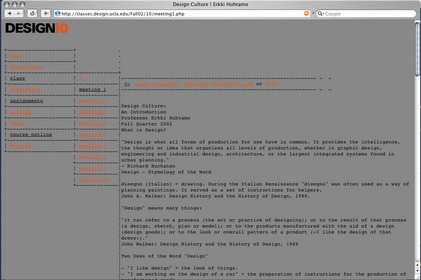SYLLABUS
UCLA Department of Design | Media Arts
Design 10 / Design Culture
Professor Erkki Huhtamo
Fall Quarter 2002
Design Culture
DESCRIPTION
Design has become a powerful force in contemporary culture and society. It surrounds
our daily lives wherever we go and whatever we do. It has an impact on us, whether we are aware of it or not. Its forms are constantly proliferating. At the same time its
boundaries are becoming more and more blurred, hard to define. It is becoming increasingly difficult - according to some, impossible - to state where design ìendsî and
phenomena like art, architecture and popular media ìbeginî. Behind the magic surrounding the word ìdesignî it is not even easy to provide a definition for the things it
is supposed to denote. One thing is sure: design is not just about creating ìcoolî looking things, it is much more than that. Like the CEO of IBM, Thomas Watson Jr. said in
1975, ìGood Design is Good Businessî, but even this is not sufficient. Design is also an ideology, that affects our ways of seeing the world. It is a form of communication too -
by creating or using certain designs we send a message about ourselves to others. There are no objects in contemporary society that have not been designed.
This lecture course provides a broad overview of the development of those phenomena that make up the ìculture of design". It demonstrates that design does not only mean the
"high design" of famous star designers and design companies. Much of the most efficient design is invisible - devices like door knobs and traffic lights help us lead our lives
without drawing attention to themselves as ìdesignî objects. To understand the culture of design we must pay attention to both kinds of objects. We also have to explain the
motives that guided their planning, their marketing, their reception and their actual uses.
Beginning from the 18th century, the lectures will deal with the main movements and trends in the history of design as a cultural phenomenon. Particular emphasis will be
given to the interconnections between design and new technologies. The relationship of design to art will also be discussed in various contexts (from the Victorian era to early 20th century modernism; from the 1960s pop culture to Postmodernism). A rich variety of demonstration material ranging from classical industrial design to recent postmodern
design trends will be presented.
GRADING AND ASSIGNMENTS
There will be a midterm assignment and a final assignment. Together with the final assignment, a short ìbook reviewî (2-3 pages) of John Heskettís Industrial Design has
to be submitted. In addition, in the beginning of each meeting there will be a short quiz, based on the previous lectureís material and the assigned reading. The grading consists of the midterm assignment (30 %), the final assignment (50 %), the quizes (10%) and the ìbook reviewî (10%). More than two absences (without the teacher's permission) from the class meetings will have a negative effect on the overall grade.
TEXTS
REQUIRED READINGS:
The following publications are required:
- John Heskett: Industrial Design. London: Thames & Hudson, 2001. This book will be available for purchase at the LU VALLE COMMONS book store ($ 14.95).
- A class reader. Will be available for purchase during the second weekís meeting.
It is strongly recommended to buy both the class reader and Heskettís book. A limited number of copies will also on reserve for consultation at the Arts Library (Public Policy
Building).
RECOMMENDED READINGS:
The following books are recommended as optional background readings. Copies are on
reserve at the Arts Library (Public Policy Building):
- Design History. A Students' Handbook. Edited by Hazel Conway. London and New York: Routledge, 1999 (orig.1987).
- Joseph J. Corn & Brian Horrigan: Yesterday's Tomorrows: Past Visions of the American Future, Baltimore: Johns Hopkins University Press 1996.
- VilÈm Flusser: The Shape of Things. A Philosophy of Design, London: Reaktion Books, 1999.
- Adrian Forty: Objects of Desire. Design and Society 1750-1980. London: Thames and Hudson, 1986.
- Guy Julier: The Culture of Design, Thousand Oaks, California: SAGE Publications, 2000.
-Ellen Lupton: Mechanical Brides. Women and Machines from Home to Office. Cooper- Hewitt National Museum of Design/Smithsonian Institution and Princeton Architectural
Press, 1993.
- Donald A. Norman: The Design of Everyday Things. Cambridge, Mass.: The MIT Press, 1998.
